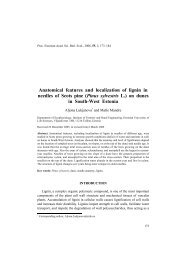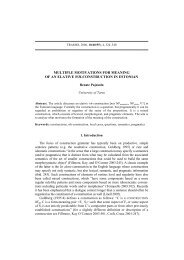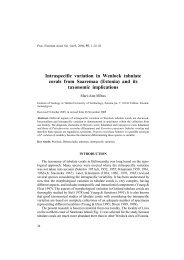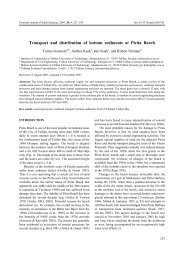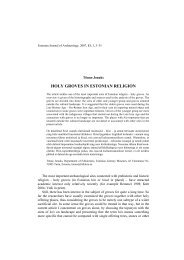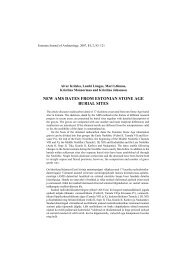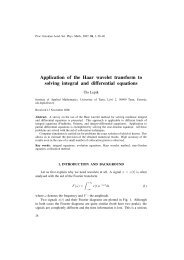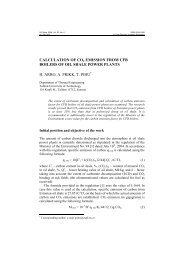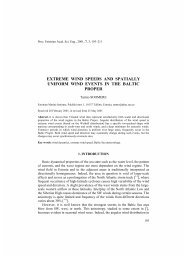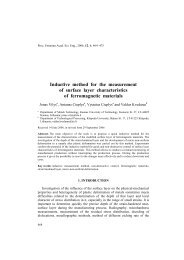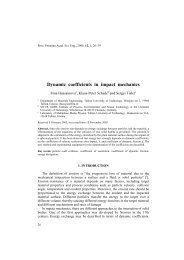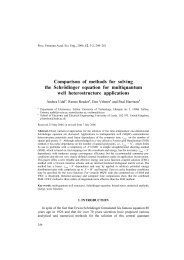PILLE PENJAM (Tartu) DEVELOPMENT OF THE MODAL ... - CEEOL
PILLE PENJAM (Tartu) DEVELOPMENT OF THE MODAL ... - CEEOL
PILLE PENJAM (Tartu) DEVELOPMENT OF THE MODAL ... - CEEOL
Create successful ePaper yourself
Turn your PDF publications into a flip-book with our unique Google optimized e-Paper software.
Pille Penjam<br />
constructions where the subject was a singular noun that referred to an<br />
inanimate creature or an impersonal referent; thus, from the very beginning<br />
the necessive verb in the construction was in the third person singular.<br />
(Laitinen 1993 : 169) Also, one might think of the Estonian tulema-verb in<br />
the sense ’start to be, exist in the future’ as the required precondition for<br />
the action described by its non-finite dependent and, thus, suspect its<br />
common origin with the other necessive verbs. Moreover, the tulema-verb<br />
is used modally only in the third person singular (or it acts as a dependent<br />
to some other verb in the third person singular). Unlike what is<br />
described by L. Laitinen the tulema-construction is congruent in earlier<br />
texts.<br />
The use of the Finnish and the Estonian tulla-construction is different<br />
in that to this day in Finnish the tulla-construction has occurred mostly<br />
in literary texts and not in dialect texts (Saukkonen 1965 : 152); the tulemaconstruction,<br />
however, is rather common in the dialects,8 e.g.<br />
(47) ve^rGu-D tule-vaD me^rDe la^ssa (Jõelähtme)<br />
net-PL come-3PL cast+daINF<br />
’nets have to be dropped into the sea’<br />
(48) ºena-t á tul^e-vaD s$aDu tih-^a kui naD kußiv^aD on (Anna)<br />
hay-PL come-3PL make-daINF<br />
’the hay has to be stacked while it’s dry’<br />
(49) sußll^e tul^e-B a^u a^nDa<br />
come-3SG honour+PRT give+daINF<br />
tul^e-B miD^al a^nDa k≈eh^e (Kodavere)<br />
come-3SG medal-SG give+daINF<br />
’one has to honour you, a medal has to be awarded immediately’<br />
(50) el^äjä tul^e-va a^iDa la^ske (Nõo)<br />
animal+PL come-3PL let+daINF<br />
’the animals should be allowed to enter the pen’<br />
(51) neo¿ maéra¿ tul^≤e-va¿ m≈e^sk≤e¿ (Põlva)<br />
this+PL berry+PL come-3PL wash+daINF<br />
’these berries need washing’<br />
Although one should not overestimate the trustworthiness of dialect<br />
material (the literary language had influenced spoken language already<br />
for a few centuries by the time Estonian and Finnish dialect texts were<br />
collected), nevertheless dialect texts could serve as a basis for the hypothesis<br />
that in Finnish and Estonian the tulema-construction may have developed<br />
differently. In Estonian it came into existence as a result of language-internal<br />
development; in Finnish, however, it had a literary background from the<br />
very beginning, and its occurrence in the earliest texts is related to the<br />
emergence of a similar construction in Swedish.<br />
The Estonian language separated from the Finnic dialects in the second<br />
millennium AD (Rätsep 1989). Assuming that the tulema-construction is<br />
original and peculiar to Estonian, one has to conclude that it must be of<br />
rather recent origin. However, it does not rule out the possibility that the<br />
8 The dialect examples come from the general card index of dialect vocabulary at<br />
the Institute of the Estonian Language.<br />
184



